How to Read Recycling Symbols
Which Plastics Are Recyclable in Regina
Below we have outlined the 7 different types of plastics. Familiarize yourself with them and see which ones can’t be recycled.
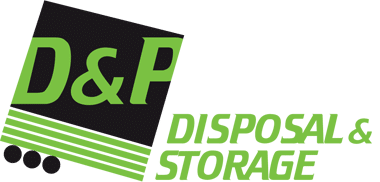
Types of Plastic
Have you noticed the number imprinted inside the recycling symbol?
Many people assume that symbol means it is recyclable. But, these numbers are a resin identification code. The code tells you what kind of plastic that made the material.
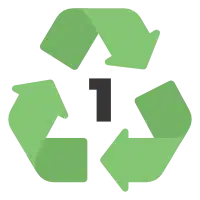
Polyethylene Terephthalate (PET)
PET is a clear, hard plastic generally used as a single-use food and drink container (water bottles, pop bottles, vegetable oil etc).
It is the most widely recycling plastic and can be recycled into fibres for carpet, tote bags, jackets, containers, and strapping.
PET does not degrade easily during the recycling process. Thus has a lower risk of trapping decomposition products that can then leach out. Its recycling rates remain low (around 20%). Even though the material is in high demand by manufacturers.
Found in:
Soft drinks, water, ketchup and beer bottles; mouthwash bottles; peanut butter containers; salad dressing; vegetable oil containers
How to recycle:
PET is common through most curbside recycling programs. As long as it’s been emptied and rinsed of any food. There’s no need to remove bottle labels because the recycling process separates them.
Recycled into:
- Polar fleece,
- fiber,
- tote bags,
- furniture,
- carpet,
- paneling,
- straps,
- bottles and
- food containers

High-density Polyethylene (HDPE)
HDPE (high-density polyethylene) is a versatile plastic. With many uses, especially when it comes to packaging. It carries low risk of leaching and is readily recyclable into many types of goods.
HDPE is a hard plastic. Often used for household cleaners, shampoo bottles, and yogurt containers. Accepted worldwide because it is one of the easier polymers to recycle.
![]() Found in:
Found in:
- Milk jugs; juice bottles; bleach, detergent and other household cleaner bottles; shampoo bottles; some trash bags and shopping bags; motor oil bottles; butter and yogurt tubs; cereal box liners.
![]() How to recycle it:
How to recycle it:
-
HDPE can be recycled,
-
The sprayers on spray bottles are not recyclable. They are often composed of multiple types of plastic. And often contain other materials like metal springs
![]() Recycled into:
Recycled into:
- Laundry detergent bottles, oil bottles, pens, recycling containers, floor tiles, drainage pipes, lumber, benches, doghouses, picnic tables, fencing and shampoo bottles
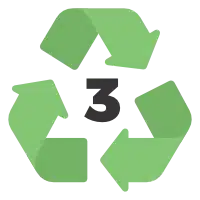
Polyvinyl chloride (PVC)
PVC (polyvinyl chloride) and V (vinyl) are tough and weather well. They’re used for things like piping and siding. PVC is also cheap, so it’s found in plenty of products and packaging.
This plastic material has a high chlorine content. It also has high levels of hazardous additives to create the desired material. It is often the primary plastic for vinyl, pipes, fencing, panels and decks. They have a lifetime of 30-50 years.
Remember to never burn PVC, because it releases toxins.
![]() Found in:
Found in:
- Blister packaging, wire jacketing, siding, windows and piping
![]() How to recycle it:
How to recycle it:
- PVC and V can rarely be recycled, but they are accepted by some plastic lumber makers.
![]() Recycled into:
Recycled into:
- Decks, paneling, mud flaps, roadway gutters, flooring, cables, speed bumps and mats

Low-density polyethylene (LDPE)
LDPE (low-density polyethylene) is a flexible plastic with many applications. This is the soft, flexible plastic. Usually used for plastic shopping bags, and frozen food storage bags.
LDPE is not recycled through curbside programs. That would mean anything made with LDPE (like toothpaste tubes) should thrown in the trash.
![]() Found in:
Found in:
- Squeezable bottles; bread, frozen food, dry-cleaning and shopping bags; Ziploc bags; tote bags; furniture
![]() How to recycle it:
How to recycle it:
- Not many curbside recycling programs accept PS in the form of rigid plastics (and many manufacturers have switched to using PET instead). Because foam products tend to break apart into smaller pieces, you should place them in a bag, squeeze out the air and tie the bag up before putting it in the trash to prevent pellets from dispersing.
![]() Recycled into:
Recycled into:
- Trash can liners and cans, compost bins, shipping envelopes, paneling, lumber, landscaping ties and floor tiles
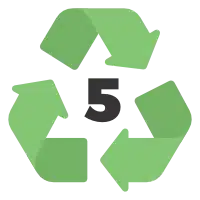
Polypropylene (PP)
Polypropylene has a high melting point, so it’s often chosen for containers that hold hot liquid. It’s gradually becoming more accepted by recyclers.
![]() Found in:
Found in:
- Some yogurt containers; syrup and medicine bottles; caps; straws
![]() How to recycle it:
How to recycle it:
- Not many curbside recycling programs accept PS in the form of rigid plastics (and many manufacturers have switched to using PET instead). Because foam products tend to break apart into smaller pieces, you should place them in a bag, squeeze out the air and tie the bag up before putting it in the trash to prevent pellets from dispersing.
![]() Recycled into:
Recycled into:
- Signal lights, battery cables, brooms, brushes, auto battery cases, ice scrapers, landscape borders, bicycle racks, rakes, bins, shipping pallets and trays
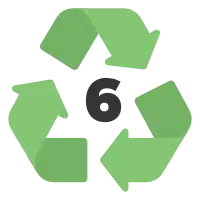
Polystyrene (PS)
![]() Found in:
Found in:
- Disposable plates and cups; meat trays; egg cartons; carryout containers, aspirin bottles and CD cases
![]() How to recycle it:
How to recycle it:
- Not many curbside recycling programs accept PS in the form of rigid plastics (and many manufacturers have switched to using PET instead). Because foam products tend to break apart into smaller pieces, you should place them in a bag, squeeze out the air and tie the bag up before putting it in the trash to prevent pellets from dispersing.
![]() Recycled into:
Recycled into:
- Insulation, light switch plates, egg cartons, vents, rulers, foam packing and carryout containers
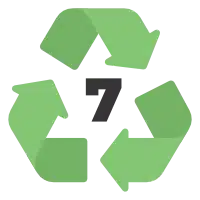
Miscellaneous / Other Plastics
The least desirable type of plastic. Large plastic containers, mixed plastic containers and water cooler bottles are generally made from PC. Multi-resin and mixed plastics also fall into this category. One of the main ways to recycle is through chemical recycling. Which consists shredding plastics into smaller pieces. Then mixing the pieces with water and a catalyst or enzyme. To break the plastic down into smaller polymer).
A wide variety of plastic resins that don’t fit into the previous categories. Become lumped into this category. Polycarbonate is a #7 plastic. PLA (polylactic acid), made from plants and is carbon-neutral, also falls into the #7 category.
![]() Found in:
Found in:
- Three- and five-gallon water bottles, bulletproof materials, sunglasses, DVDs, clear plastic cutlery, lighting fixtures, signs and displays, certain food containers, nylon
![]() How to recycle:
How to recycle:
- These other plastics are traditionally not recycled.
![]() Recycled into:
Recycled into:
-
Plastic lumber and other custom-made products
D&P Disposal & Storage is Regina-owned and operated. The rental business provides garbage bin rentals and mobile storage unit/pup rentals. Our business was established in 2013.
Since then we have been providing courteous professional affordable rental services to the residents and businesses of Regina and the surrounding area.
Regina Garbage Bin & Storage Pup/Container Rentals
Site Developed by Omni Studios | Search Engine Optimization by Regina SEO